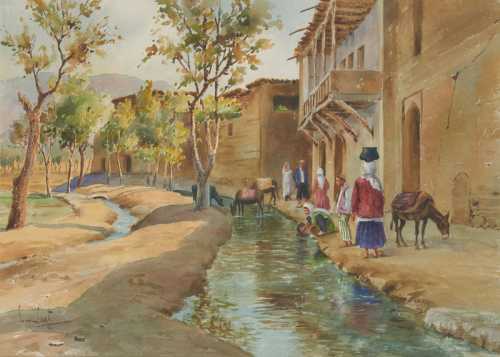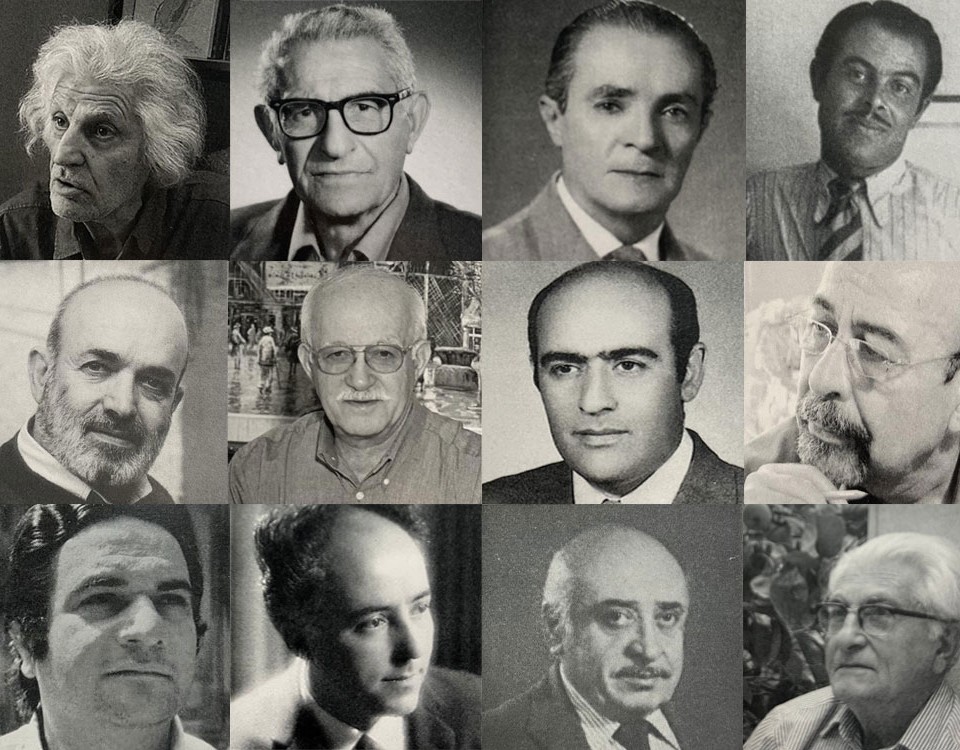About Sumbat Der Kiureghian
Sumbat Der Kiureghian was born in 1912 in an Armenian family in Jolfa, Isfahan. At the age of seven, Sumbat's artistic talent was noticed by his older sister, but the turning point of his artistic life and the reason for his return to art was the arrival of Sarkis Khachatourian, a famous Armenian painter living in Paris, to Isfahan to paint the magnificent murals of Aali Qapu and Chehel sotoon.
He learned a lot from Khachatourian's skill in using brushes and choosing colors, and from his knowledge of the works of Western, Indian, Japanese, and African artists. He was also a student of masters such as Hakoup Vartanian, Yeghia Valijanian, and Sir William Russell Flint (an eminent English watercolorist).
Sumbat's paintings' subjects are narrowed down to Iran's people, architecture, and nature. In addition to the bridges, palaces, squares, alleys, and markets of Isfahan. His watercolor paintings are focused on the people in those neighborhoods, native people, and daily life; Something that was less noticed by painters at that time; Therefore, Sumbat is known as an anthropological painter. He was the narrator of Iranian life and Iranian people.
In 1930, Sumbat Der Kiureghian opened a gallery called Sumbat Gallery on Chaharbagh Street, Isfahan. Sumbat continued his artistic activity in Isfahan until 1971 when he came to Tehran and in 1972 established his gallery in Tehran. Sumbat Der Kiureghian immigrated to America in 1980 and died after 20 years.
He learned a lot from Khachatourian's skill in using brushes and choosing colors, and from his knowledge of the works of Western, Indian, Japanese, and African artists. He was also a student of masters such as Hakoup Vartanian, Yeghia Valijanian, and Sir William Russell Flint (an eminent English watercolorist).
Sumbat's paintings' subjects are narrowed down to Iran's people, architecture, and nature. In addition to the bridges, palaces, squares, alleys, and markets of Isfahan. His watercolor paintings are focused on the people in those neighborhoods, native people, and daily life; Something that was less noticed by painters at that time; Therefore, Sumbat is known as an anthropological painter. He was the narrator of Iranian life and Iranian people.
In 1930, Sumbat Der Kiureghian opened a gallery called Sumbat Gallery on Chaharbagh Street, Isfahan. Sumbat continued his artistic activity in Isfahan until 1971 when he came to Tehran and in 1972 established his gallery in Tehran. Sumbat Der Kiureghian immigrated to America in 1980 and died after 20 years.
The Most Expensive Artwork
At Auctions
First Attendance
20 March 2018
# Attendance
13
# Artworks
24
Average Realized Price
2,563 USD
Average Min Estimate
1,880 USD
Average Max Estimate
2,648 USD
Sell-through Rate
91.304%
Average Growth of Artwork Worth
114.111%
Timeline
The Traditional Collector auction
29 October
CHARSOO- Part 2 exhibition
3 October
Resize exhibition
16 August
Timed sale of paintings and artworks auction
11 March
A Glance at Sketching exhibition
8 March
Weekly auction
6 October
Lotfi x Mashahir Cross 2 exhibition
9 September
Opportunity exhibition
13 February
Antiques, Collectables and General Sale auction
26 January
Fine Estate New Year (Day 2) auction
23 January
INTERNATIONELL KVALITETSAUKTION auction
15 June
Small Artworks collection exhibition
11 June
The New Jolfa exhibition
23 April
Middle Eastern Art Online Sale auction
9 March
Modern and Contemporary Middle Eastern Art auction
24 November
Orientalist Paintings Online auction
5 June
Collectioner 4 exhibition
29 November
The Sound of Autumn and Winter exhibition
15 November
Silver and Fine Art auction
13 September
یازدهمین دوره حراج تهران auction
5 July
The 9th Tehran- Classic and Modern Iranian Art auction
29 June
March Quarterly Decorative & Fine Arts auction
20 March
Group Painting Show exhibition
10 February
Articles
A short analysis of Isfahan school watercolor painters' market 25 January 2023
Isfahan school watercolor painters' artworks have recently gained attention and are sold in domestic and foreign auctions. This essay, gives a brief introduction and a report on the market of Isfahan school watercolor painters.

